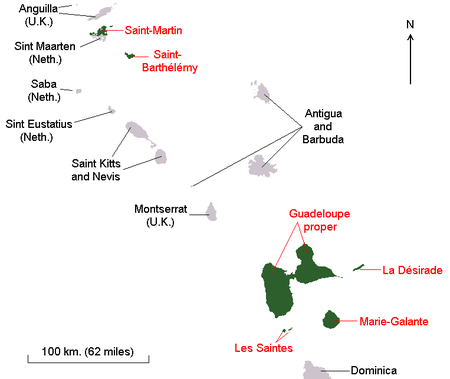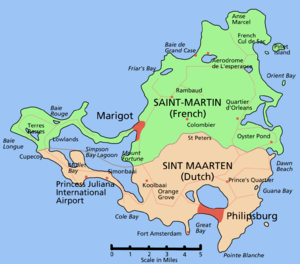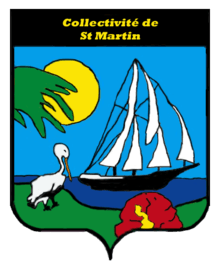Collectivity of Saint Martin
| Collectivity of Saint Martin Collectivité de Saint-Martin
|
||||||
|---|---|---|---|---|---|---|
|
||||||
| Anthem: La Marseillaise Territorial song: O Sweet Saint Martin's Land |
||||||
 Location of the Collectivity of St Martin in the Leeward Islands.
|
||||||
 |
||||||
| Capital and largest city | Marigot | |||||
| Official languages | French | |||||
| Ethnic groups ([1]) |
|
|||||
| Government | Dependent territory | |||||
| - | President of France | François Hollande | ||||
| - | Prefect | Jacques Simonnet | ||||
| - | President of the Territorial Council |
Aline Hanson (RRR) | ||||
| Overseas collectivity of France | ||||||
| - | Divided between France and Netherlands | 23 March 1648 | ||||
| - | Separate collectivity | 15 July 2007 | ||||
| Area | ||||||
| - | Total | 53.2 km2 (unranked) 20.5 sq mi |
||||
| - | Water (%) | negligible | ||||
| Population | ||||||
| - | Jan. 2011 census | 36,286[2] (unranked) | ||||
| - | Density | 682/km2 (unranked) 1,767/sq mi |
||||
| Currency | Euro (€) (EUR) |
|||||
| Time zone | (UTC-4) | |||||
| Calling code | +590c | |||||
| ISO 3166 code | MF | |||||
| Internet TLD | ||||||
| a. | French East Asians. | |||||
| b. | Assigned but not in use. | |||||
| c. | Shared with Guadeloupe and Saint Barthélemy. | |||||
Saint Martin (French: Saint-Martin), officially the Collectivity of Saint Martin (French: Collectivité de Saint-Martin) is an overseas collectivity of France located in the Caribbean. It came into being on 15 July 2007,[note 1] encompassing the northern parts of Saint Martin island and neighbouring islets, the largest of which is Île Tintamarre. The southern part of the island, Sint Maarten, is one of the four constituent countries that form the Kingdom of the Netherlands.
Its capital is Marigot. It has a population of 36,286 (as of Jan. 2011)[2] on 53.2 square kilometres (20.5 sq mi).
It is separated from the British Overseas Territory of Anguilla by the Anguilla Channel.
Politics and government
Saint Martin was for many years a French commune forming part of Guadeloupe, which is an overseas région and département of France and is therefore in the European Union. In 2003 the population of the French part of the island voted in favour of secession from Guadeloupe in order to form a separate overseas collectivity (COM) of France.[3] On 9 February 2007, the French Parliament passed a bill granting COM status to both the French part of Saint Martin and (separately) the neighbouring Saint Barthélemy.[4] The new status took effect once the local assembly was elected on 15 February 2007.[5] Saint Martin remains part of the European Union.[6]
The new governance structure befitting an overseas collectivity took effect on 15 July 2007 with the first session of the Territorial Council (French: Conseil territorial) and the election of Louis-Constant Fleming as president of the Territorial Council. On 25 July 2008 Fleming resigned after being sanctioned by the Conseil d'État for one year over problems with his 2007 election campaign.[7] On 7 August, Frantz Gumbs was elected as President of the Territorial Council.[8] However, his election was declared invalid on 10 April 2009 and Daniel Gibbs appointed as Acting President of the Territorial Council on 14 April 2009.[9] Gumbs was reelected on 5 May 2009.[10]
Before 2007, Saint Martin was coded as GP (Guadeloupe) in ISO 3166-1. In October 2007, it received the ISO 3166-1 code MF (alpha-2 code), MAF (alpha-3 code), and 663 (numeric code).[11]
| Parties | 1st round | 2nd round | Seats | ||||
|---|---|---|---|---|---|---|---|
| Votes | % | Votes | % | ||||
| Union for Progress/UMP (Union pour le Progrès, Louis Constant-Fleming) | 2,829 | 40.35 | 3,753 | 48.96 | 16 | ||
| Rally Responsibility Success (Rassemblement responsabilité réussite, Alain Richardson) | 2,237 | 31.90 | 3,231 | 42.15 | 6 | ||
| Succeed Saint Martin (Réussir Saint-Martin, Jean-Luc Hamlet) | 767 | 10.94 | 681 | 8.89 | 1 | ||
| Alliance (Alliance, Dominique Riboud) | 635 | 9.05 | — | — | — | ||
| Democratic Alliance for Saint Martin (Alliance démocratique pour Saint-Martin, Wendel Cocks) | 544 | 7.76 | — | — | — | ||
| Total | 7,012 | 100.00 | 7,665 | 100.00 | 23 | ||
| Source: RFO1, RFO2 | |||||||
Coat of arms
The coat of arms of the French overseas collectivity Saint-Martin features a ship, a palm and a sun, and reads "Collectivité de Saint Martin".[12] The comune that existed until 22 February 2007, used similar arms but with the legend "Ville de Saint Martin".[13][14]
Demographics
The French part of the island has a land area of 53.2 square kilometres (20.5 sq mi). A local English-based dialect is spoken in informal situations on both the French and Dutch sides of the island.[15] At the January 2011 French census, the population in the French part of the island was 36,286[2] (up from only 8,072 inhabitants at the 1982 census), which means a population density of 682 inhabitants per square kilometre (1,770 /sq mi) in 2011.
| 1885 | 1954 | 1961 | 1967 | 1974 | 1982 | 1990 | 1999 | 2006 | 2011 |
|---|---|---|---|---|---|---|---|---|---|
| 3,400 | 3,366 | 4,502 | 5,061 | 6,191 | 8,072 | 28,518 | 29,078 | 35,263 | 36,286 |
| Official figures from French censuses. | |||||||||
Economy

The official currency of Saint Martin is the euro, though the US dollar is also widely accepted. Tourism is the main economic activity.
INSEE estimated that the total GDP of Saint Martin amounted to 421 million euros in 1999 (US$449 million at 1999 exchanges rates; US$599 million at Oct. 2007 exchange rates).[16] In that same year the GDP per capita of Saint Martin was 14,500 euros (US$15,500 at 1999 exchanges rates; US$20,600 at Oct. 2007 exchange rates), which was 39% lower than the average GDP per capita of metropolitan France in 1999.[16] In comparison, the GDP per capita on the Dutch side of the island, Sint Maarten, was 14,430 euros in 2004.[17]
Maps



See also
- Culture of St. Martin
- History of St. Martin
- List of divided islands
Notes
- ↑ The French law was passed in February 2007, but the new status only came in force once the local assemblies were elected, with the second leg of the vote ultimately occurring on 15 July 2007. See J. P. Thiellay, Droit des outre-mers, Paris:Dalloz, 2007.
References
- ↑ World factbook Saint Martin
- ↑ 2.0 2.1 2.2 INSEE, Government of France. "Populations légales 2011 pour les départements et les collectivités d'outre-mer". Retrieved 2014-01-26. (French)
- ↑ Staff reporter, last= (9 December 2003). "French Caribbean voters reject change". Caribbean Net News. Retrieved 9 February 2007. "However voters on the two tiny French dependencies of Saint-Barthelemy and Saint-Martin, which have been administratively attached to Guadeloupe, approved the referendum and are set to acquire the new status of "overseas collectivity"."
- ↑ Staff reporter (9 February 2007). "Saint-Barth To Become An Overseas Collectivity" (PDF). St. Barth Weekly. p. 2. Retrieved 9 February 2007.
- ↑ Les élections du futur conseil territorial font débat - Politique - Nouvelles sur Newmedia.fr - New Media : Infos Guadeloupe, Martinique, Guyane, Saint-Martin, Saint-Barthelémy, Caraïbes - Infos Newmedia.fr
- ↑ The Treaty of Lisbon states that Saint-Martin is a part of the EU. See: "Treaty of Lisbon, Article 349 and 355". Retrieved 18 March 2010..
- ↑ Staff reporter (28 July 2008). "Louis-Constant Fleming démissionné par le conseil d’Etat" (in French). fxgpariscaraibe. Retrieved 17 August 2008.
- ↑ Staff reporter (8 August 2008). "Frantz Gumbs elected new president of Collectivité". The Daily Herald. Retrieved 17 August 2008. "Frantz Gumbs, formerly president of Union Pour le Progrès (UPP) party, swept into power as new president of the Collectivité at an extraordinary meeting of the Territorial Council on Thursday after winning the 23-councillor vote with a clear majority over Marthe Ogoundélé-Tessi."
- ↑ http://www.thedailyherald.com/news/daily/l278/shamel278.html
- ↑ http://rulers.org/2009-05.html
- ↑ ISO 3166-1 Newsletter. Assignment of code elements for Saint Barthélemy and Saint Martin and update of France and other French Territories
- ↑
- ↑
- ↑
- ↑ Holm (1989) Pidgins and Creoles, vol. 2
- ↑ 16.0 16.1 (French) INSEE, CEROM. "Estimation du PIB de Saint-Barthélemy et de Saint-Martin" (PDF). Retrieved 13 November 2007.
- ↑ Total 2004 GDP of Sint Maarten () divided by the number of inhabitants in 2004 (), then converted from Netherlands Antillean gulden to euro by using the 2004 exchange rate.
External links
| Find more about Saint Martin (France) at Wikipedia's sister projects | |
| |
Definitions and translations from Wiktionary |
| |
Media from Commons |
| |
Quotations from Wikiquote |
| |
Source texts from Wikisource |
| |
Textbooks from Wikibooks |
| |
Learning resources from Wikiversity |
- (French) Official website of the Collectivity of Saint Martin
- Official website of the Tourist Office of Saint Martin
-
 Wikimedia Atlas of Saint Martin (France)
Wikimedia Atlas of Saint Martin (France) -
 Saint Martin (France) travel guide from Wikivoyage
Saint Martin (France) travel guide from Wikivoyage - Saint Martin entry at The World Factbook
| |||||||||||||||||||||||||||
| ||||||||||||||||||||||||||||||||||||||||
| ||||||||||||||||||||||||
| |||||||||||||||||||||||||||||
| ||||||||||
| ||||||||
Coordinates: 18°4′31″N 63°3′36″W / 18.07528°N 63.06000°W





